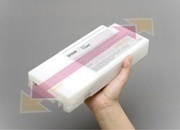Thank you!
For more information on how Epson treats your personal data, please read our Privacy Information Statement.
Submit your contact details below and an Epson expert will be in touch:
For more information on how Epson treats your personal data, please read our Privacy Information Statement.
|
Inkjet Products Key Components R&D Department
Imaging & Information Operations Division
Tsuyoshi Sano, Chief Engineer
What’s so special about Epson UltraChrome HDR Ink with White?
UltraChrome with White is comprised of resin-based hollow particles. Though this concept is not particularly new, I think it’s probably the first time this type of particle has been used for inkjet printing. The unique aspect of hollow particles is that they cause light to scatter, which results in them appearing white.
Up to now, users of solvent and UV processes have had to shake cartridges everyday since ink precipitates. Moreover, when we started development about three years ago, there had been complaints that these inks weren't dense enough, were hard to handle and could not be used in ordinary offices.
Now with our new ink, users have to shake cartridges only once a week since the white ink remains suspended in solution longer due to its hollow construction. Also, we solved the problem of particles easily collapsing by devising a new method for synthesizing the particle.
No matter how good the technology, though, unless it satisfies the needs of users it will ultimately prove worthless.
How did you solve the problem of white ink density and cost, which were what users were really concerned about?
As far as we know, there is no common standard, such as Euroscale or SWOP, for gravure printing and flexography film. So first we had to collect packages and packaging material containing white ink from locations all over the world. Then we measured the L-value of each package on black paper, after which we determined the proper density for our white ink. Also, we calculated the shielding performance of white ink by quantifying our white ink. As a result, compared with white ink from other inkjet printers as well as from different systems like liquid toner and thermal transfer, our ink achieves outstanding density that tops 90 percent of the competition.
As for concerns regarding the possibility of white and color inks mixing and not maintaining enough white density, we eliminated these by improving the composition of the white ink and decreasing the drying time for Epson ClearProof™ Film.
The color inks used in the new printer are the same as Epson UltraChrome HDR Ink. What makes the white ink different?
The major differences are the colorant and size. Other than these, there is very little difference. However, we replaced gray inks with a cleaning cartridge to avoid clogged nozzles due to the large size of the white ink particles. The cleaning cartridge injects cleaning fluid into the print head when the power is turned off order to cleanse and protect the print head. This prevents white ink from coagulating in the head.
Why did you include a “Tint” function?
There are various ways to produce package proofs, such as flexography, gravure printing, and screen printing. There are also various types of inks depending on the printing method. The Tint function lets users simulate different kinds of white such as “cool white” and “light beige” by controlling it as a spot color with color management software.
Are there any problems with misalignment between the white and color areas when using surface print and reverse print?
The press printing process is prone to misalignment because each color is individually loaded and you need to print white and color areas separately. Epson Stylus Pro WT7900 avoids this problem since all inks are printed at the same time from the same print head.
Do you think you have succeeded in meeting user demand for an easy-to-use inkjet printer that prints white?
Yes, absolutely. This new print system avoids the problems of other proofing systems, mainly color accuracy, white density, cost, odors, and maintenance. I think this is a great advantage over the other proofing systems. Epson Stylus Pro WT7900 will definitely lower running costs compared to conventional DDCP systems and really increase productivity.

Inkjet Products Key Components R&D Department, Imaging & Information Operations Division
Tsuyoshi Sano, Chief Engineer

How hollow particles scatter light to produce white. It's similar to steam coming out of a kettle. Although water itself is transparent, the steam looks like white since every particle scatters light.

Solvent and UV curable inks must be agitated daily to avoid precipitation. The white ink cartridge in Epson UltraChrome HDR Ink needs to be agitated just once a week.

The cleaning cartridge protects the print head from clogging with white ink. Additionally, a message on the LCD panel alerts users when agitation is required.
Has been successfully added to your basket